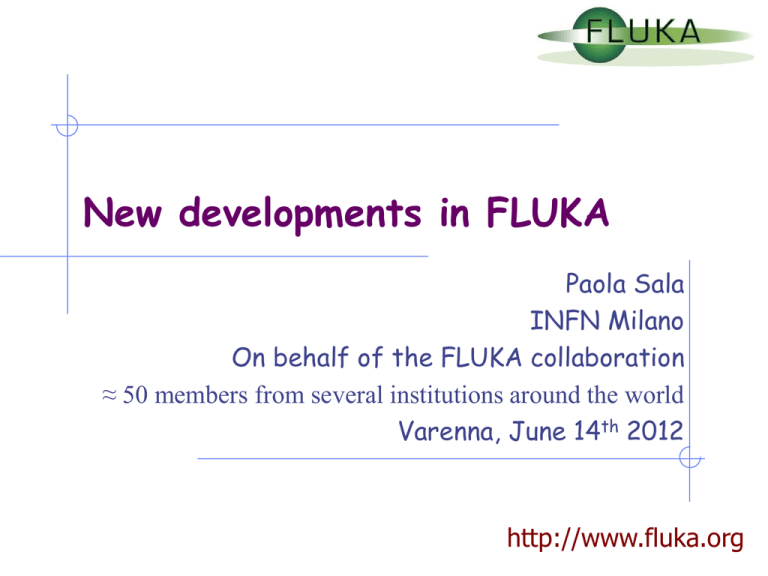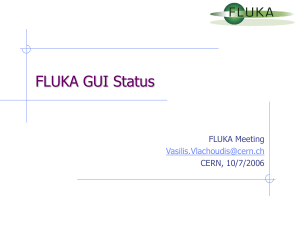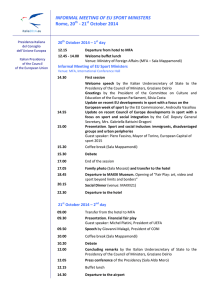FLUKA
advertisement

New developments in FLUKA Paola Sala INFN Milano On behalf of the FLUKA collaboration ≈ 50 members from several institutions around the world Varenna, June 14th 2012 http://www.fluka.org A glimpse of latest developments and applications FLUKA is a general purpose tool for calculations of particle transport and interactions with matter (all hadrons, ions, EM) FLUKA applications range from LHC or cosmic energies down to hadron-therapy (A. Mairani’s talk) and microdosimetry Standard tool at CERN for beam-machine interactions and radioprotection A long and constant development of nuclear interaction models that benefits to a wide range of applications Without forgetting EM and particle transport In this talk some news on Hadronic interactions in the few GeV energy range and neutrinos Interactions of particles below 150 MeV/A Improvements in the latest stages of nuclear reactions with examples Very high energy : examples of LHC applications June 14th, 2012 Paola Sala, Varenna2012 http://www.fluka.org 2 Hadron interactions in FLUKA: an integrated ensemble h-h DPM + quark chain hadronization h-A PEANUT A-A Glauber-Gribov multiple collisions DPMJET3 Resonance production and decay G-INC Preequilibrium (Exciton) Elastic, ch.exc. Evaporation/Fragmentation or Fermi Break-up deexcitation Neutrino June 14th, 2012 rQMD-2.4 BME Muon photonuc Photonuclear Em-dissociation Paola Sala, Varenna2012 3 DualPartonModel at its lower limit Strong experimental effort is ongoing on particle production from beams in the few to tens of GeV range Important for neutrino beams and interactions Challenging: too high energy for resonance formation, too low for quark gluon based models Fluka high energy hadron-hadron interaction model – DPM-: chain production and chain hadronization Strong mass effects for low energy chains “standard” hadronization outside its validity region NEW: gradual transition of low energies chains to “phase space explosion” constrained in pT , including baryons, mesons, resonances. June 14th, 2012 Paola Sala, Varenna2012 4 Neutrino interactions (ICARUS..): Fluka has its own neutrino interaction generator, including QE, Resonance, DIS DIS uses the same chain hadronization as DPM Embedded in the FLUKA nuclear environment (PEANUT) New low-mass chain treatment-> improvements in the RES-DIS transition μ+p ->μ- +p++ June 14th, 2012 Paola Sala, Varenna2012 5 Pion production close to DPM thr. Pion production from proton interactions on Be at 12.3 GeV Emitted pion spectra at different angles in the range 300 - 600 Dots: data (BNL910 expt.), histograms : Fluka + - June 14th, 2012 Paola Sala, Varenna2012 6 Pion production close to DPM thr. Pion production from proton interactions on Be at 17.5 GeV Emitted pion spectra at different angles in the range 00 - 200 Dots: data (BNL910 expt.), histograms : Fluka - + + June 14th, 2012 Paola Sala, Varenna2012 7 -induced reactions, -emitters Fragmentation tail in hadrontherapy beams Radiation damage to electronics Production of residual nuclei: On heavy targets, interactions of secondary ’s can produce dangerous radioisotopes, for instance: (, Bi ) At : chemically reactive (halogen) and + emitters. Eg, 21085At has a mean life of 8.1 h, 5.6 MeV decay and decay to 21084Po (, Pb ) Po ...well known “problematic” -emitters Some of these isotopes have exemption limits 3-4 order of magnitudes smaller than most other radioisotopes commonly produced at accelerators New in FLUKA: - induced reactions at low energy (E < 150 MeV/A) through the BME model At higher energies: already handled through the rQMD-2.4 and DPMJET-3 models June 14th, 2012 Paola Sala, Varenna2012 8 FLUKA: the BME Model for nucleus – nucleus interactions below 150 MeV/n The BME ( Boltzmann Master Equation) in FLUKA It works for Aproj,Atarg 4, E 150 MeV/A 1. COMPLETE FUSION 2. PERIPHERAL COLLISION three body mechanism Fragment(s) : pre-equilibrium de-excitation according to the BME theory (where available) or to the PEANUT exciton model evaporation/fission/fragmentation/ gamma de-excitation, same as for hadron-nucleus interactions with incomplete fusion one nucleon break-up and possibly transfer (at high b) pickup/stripping (for asymmetric systems at low b) The kinematics is suggested by break-up studies. BME : E. Gadioli group in Milano June 14th, 2012 Paola Sala, Varenna2012 9 BME in FLUKA : (,xn) examples Excitation functions for the production of radioisotopes from interactions on Au (left) and Pb ( right) (Data: CSISRS, NNDC) June 14th, 2012 Paola Sala, Varenna2012 10 Gamma De-excitation in Fluka At the end of evaporation : cascade of transitions At high excitation: assume continuous level density and statistical emission: f (U f ) P( E )dE f ( E , L) L i (U i ) f = strength from single particle estimate (c)+ hindrance (F) L= multipole order =level density at excitation energy. U f (E , L) cL FL ( A)E(2L1) At low excitation: through discrete levels Tabulated experimental levels (partial coverage) Rotational approximation outside tabulations See A. Ferrari et al., Z. Phys C 71, 75 (1996) June 14th, 2012 Paola Sala, Varenna2012 11 Ongoing developments for ’s: Extended database of known levels and transitions taken from RIPL-3 (IAEA) Discrete level treatment extended to evaporation stage Already inserted in the released FLUKA2011.2 Photon angular distribution according to multipolarity and spin ( effort to estimate residual spin value and direction in PEANUT, BME, rQMD) Account for discrete levels in BME (to be extended to rQMD and DPMJET) Application : prompt photon for in-vivo hadron therapy monitoring June 14th, 2012 Paola Sala, Varenna2012 12 Prompt photons: benchmarks I Prompt photons measured during irradiation of water and PMMA phantoms with C ions. Photon spectra measured at 900 wrt beam Time-of-flight to discriminate neutron background [figures and exp. data taken from F. Le Foulher et al IEEE TNS 57 (2009),E. Testa et al, NIMB 267 (2009) 993] and later revisions Threshold at 2 MeV to discriminate prompt photons from secondary photons, bremsstrahlung etc. 13 Results Bragg peak position 95 MeV/u Counts/ion vs position along the phantom (mm) 310 MeV/u Exp. Energy/tof Distribution and Window Scatter plot and exp. data taken from F. Le Foulher et al IEEE TNS 57 (2009) and later revisions Bckg subtraction from data to equalize the bckg.level before the target Blue: fluka Red: data 14 Photon yields by 160 MeV p in PMMA Absolute comparison Energy spectrum of “photons” after background subtraction (collimator open – collimator closed) for 160 MeV p on PMMA. FLUKA red line, data black line (J.Smeets et al., ENVISION WP3) June 14th, 2012 Paola Sala, Varenna2012 15 Spin-parity in Fermi-Break-up For A<16, evaporation is substituted by Fermi break-up In cases where spin and parity of the residual nucleus are known, conservation laws, constraints on available configurations and centrifugal barrier (if L=0 is forbidden), are enforced in the fragment production Straightforward example : photonuclear reaction in the GDR region Effect : residual nuclei production Application: background from induced activity in underground experiments 12C + in GDR J = 1 3 and + 8Be impossible in L=0 Factor 3 on 11C production June 14th, 2012 Paola Sala, Varenna2012 16 Examples at LHC June 14th, 2012 Paola Sala, Varenna2012 17 Application at 3.5+3.5 TeV (2.6 1010 MeV eq. in lab) BLM response along triplet right of IR5 • BLM dose per collision assuming CMS luminosity measurement and 73.5 mb proton-proton cross-section (from TOTEM) • Discrepancy possibly due to geometry model (e.g. interconnections are not modeled in detail) June 14th, 2012 Paola Sala, Varenna2012 18 ElectroMagnetic dissociation at LHC Electromagnetic dissociation: sEM increasingly large with (target) Z’s and energy. Already relevant for few GeV/n ions on heavy targets (sEM ~ 1 b vs snucl ~ 5 b for 1 GeV/n Fe on Pb) d 1 n A1 () n A2 () Z12 Total electromagnetic and nuclear cross sections (barn) for Pb-Pb interactions at the energy sNN = 2.76 TeV Reaction FLUKA ALICE (arXiv:1203.2436v1 [nucl-ex].) Single EMD + nuclear 199 194.6 ± 0.3 stat +14.1/–12.1 syst nuclear 7.67 7.5 ± 0.1 stat +0.6/–0.5 syst Single EMD 191.3 187.2 ± 0.2 stat +13.8/–12.0 syst Paola Sala, HSS066 19 Work partially supported by the ENVISION and PARTNERS European programs June 14th, 2012 Paola Sala, Varenna2012 20










